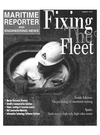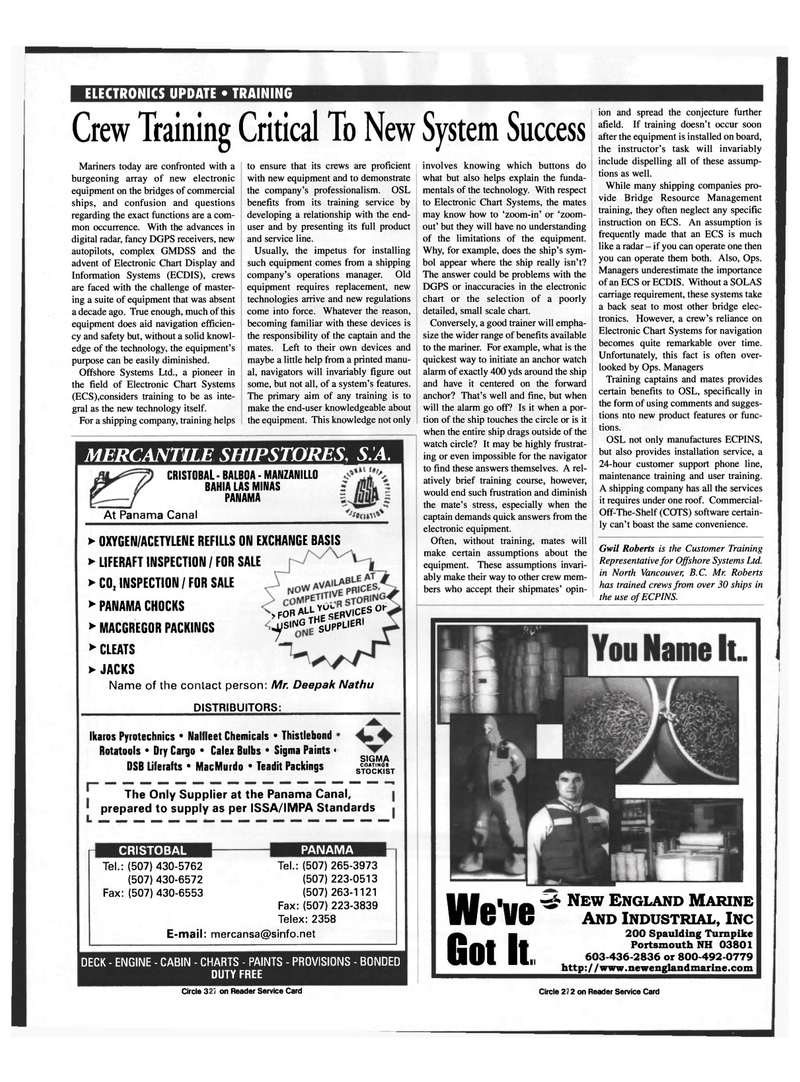
Page 54: of Maritime Reporter Magazine (March 1999)
Read this page in Pdf, Flash or Html5 edition of March 1999 Maritime Reporter Magazine
ELECTRONICS UPDATE • TRAINING
Crew Training Critical To New System Success
Mariners today are confronted with a burgeoning array of new electronic equipment on the bridges of commercial ships, and confusion and questions regarding the exact functions are a com- mon occurrence. With the advances in digital radar, fancy DGPS receivers, new autopilots, complex GMDSS and the advent of Electronic Chart Display and
Information Systems (ECDIS), crews are faced with the challenge of master- ing a suite of equipment that was absent a decade ago. True enough, much of this equipment does aid navigation efficien- cy and safety but, without a solid knowl- edge of the technology, the equipment's purpose can be easily diminished.
Offshore Systems Ltd., a pioneer in the field of Electronic Chart Systems (ECS),considers training to be as inte- gral as the new technology itself.
For a shipping company, training helps to ensure that its crews are proficient with new equipment and to demonstrate the company's professionalism. OSL benefits from its training service by developing a relationship with the end- user and by presenting its full product and service line.
Usually, the impetus for installing such equipment comes from a shipping company's operations manager. Old equipment requires replacement, new technologies arrive and new regulations come into force. Whatever the reason, becoming familiar with these devices is the responsibility of the captain and the mates. Left to their own devices and maybe a little help from a printed manu- al, navigators will invariably figure out some, but not all, of a system's features.
The primary aim of any training is to make the end-user knowledgeable about the equipment. This knowledge not only
MERCANTILE SHIPSTORES, S.A.
CRISTOBAL- BALBOA - MANZANILLO
BAHIA LAS MINAS
PANAMA
At Panama Canal • OXYGEN/ACETYLENE REFILLS ON EXCHANGE BASIS • LIFERAFT INSPECTION / FOR SALE • CO, INSPECTION /FOR SALE • PANAMA CHOCKS • MACGREGOR PACKINGS • CLEATS >FORALLY EBVlCES°r ^s.ngth|upPL1EB! • JACKS
Name of the contact person: Mr. Deepak Nathu
DISTRIBUITORS:
Ikaros Pyrotechnics • Nalfleet Chemicals • Thistlebond
Rotatools • Dry Cargo • Calex Bulbs • Sigma Paints •
DSB Liferafts • MacMurdo • Teadit Packings
SIGMA
COATINGS
STOCKIST
The Only Supplier at the Panama Canal, prepared to supply as per ISSA/IMPA Standards
CRISTOBAL PANAMA
Tel.: (507) 430-5762 (507) 430-6572
Fax:(507) 430-6553
Tel.: (507) 265-3973 (507) 223-0513 (507) 263-1121
Fax:(507)223-3839
Telex: 2358
E-mail: [email protected] involves knowing which buttons do what but also helps explain the funda- mentals of the technology. With respect to Electronic Chart Systems, the mates may know how to 'zoom-in' or 'zoom- out' but they will have no understanding of the limitations of the equipment.
Why, for example, does the ship's sym- bol appear where the ship really isn't?
The answer could be problems with the
DGPS or inaccuracies in the electronic chart or the selection of a poorly detailed, small scale chart.
Conversely, a good trainer will empha- size the wider range of benefits available to the mariner. For example, what is the quickest way to initiate an anchor watch alarm of exactly 400 yds around the ship and have it centered on the forward anchor? That's well and fine, but when will the alarm go off? Is it when a por- tion of the ship touches the circle or is it when the entire ship drags outside of the watch circle? It may be highly frustrat- ing or even impossible for the navigator to find these answers themselves. A rel- atively brief training course, however, would end such frustration and diminish the mate's stress, especially when the captain demands quick answers from the electronic equipment.
Often, without training, mates will make certain assumptions about the equipment. These assumptions invari- ably make their way to other crew mem- bers who accept their shipmates' opin- ion and spread the conjecture further afield. If training doesn't occur soon after the equipment is installed on board, the instructor's task will invariably include dispelling all of these assump- tions as well.
While many shipping companies pro- vide Bridge Resource Management training, they often neglect any specific instruction on ECS. An assumption is frequently made that an ECS is much like a radar - if you can operate one then you can operate them both. Also, Ops.
Managers underestimate the importance of an ECS or ECDIS. Without a SOLAS carriage requirement, these systems take a back seat to most other bridge elec- tronics. However, a crew's reliance on
Electronic Chart Systems for navigation becomes quite remarkable over time.
Unfortunately, this fact is often over- looked by Ops. Managers
Training captains and mates provides certain benefits to OSL, specifically in the form of using comments and sugges- tions nto new product features or func- tions.
OSL not only manufactures ECPINS, but also provides installation service, a 24-hour customer support phone line, maintenance training and user training.
A shipping company has all the services it requires under one roof. Commercial-
Off-The-Shelf (COTS) software certain- ly can't boast the same convenience.
Gwil Roberts is the Customer Training
Representative for Offshore Systems Ltd. in North Vancouver, B.C. Mr. Roberts has trained crews from over 30 ships in the use of ECPINS.
Ufo'no ^ NEW ENGLAND MARINE
W6 VB AND INDUSTRIAL, INC
Got It. 200 Spaulding Turnpike Portsmouth NH 03801 603-436-2836 or 800-492-0779 http: / / www. newenglandmarine .com DECK - ENGINE - CABIN - CHARTS - PAINTS - PROVISIONS - BONDED
DUTY FREE
March, 1999 Circle 305 on Reader Service Card Circle 282 on Reader Service Card

 53
53

 55
55
